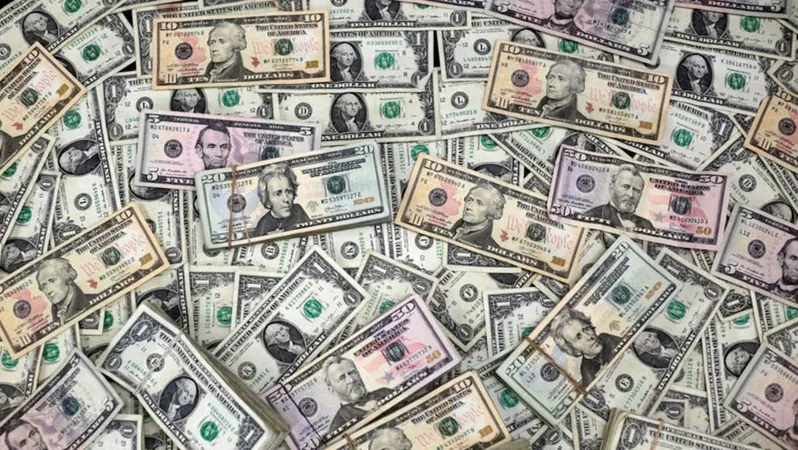
The US Dollar Dominates as the Euro Stumbles Amid Market Recalibration
2025-03-21
Author: Nur
The Rise of the U.S. Dollar
In a significant shift on Friday, the U.S. dollar experienced a notable rise against major currencies, particularly the euro, which is poised for its first weekly decline this month. This development unfolded on the heels of a pivotal week for central banks amidst growing concerns over the implications of a global trade war.
U.S. Dollar Index Performance
The U.S. dollar index, which measures the currency against a basket of six other major currencies, climbed 0.19% to reach 103.99. This increase follows a robust 0.36% gain seen on Thursday, marking its best performance in three weeks. The boost in the dollar’s value comes after the Federal Reserve (Fed) signaled that it is not in a rush to cut interest rates, instilling confidence in investors.
Euro's Decline
Conversely, the euro dipped by 0.15% to $1.0836 following a 0.45% drop the previous day. The euro is anticipated to close the week down by 0.4%, despite a strong two-week performance driven by Germany's ambitious spending plans aimed at rejuvenating its economy.
Germany's Economic Initiatives
Recently, Germany's Bundesrat, the upper parliament, enacted reforms to the nation’s borrowing regulations and established a substantial €500 billion fund targeting infrastructure improvement. This initiative aims to stimulate Europe's largest economy, with proposals gaining approval from the lower house earlier this week.
Market Reactions
The euro had previously gained traction amid enthusiasm for the spending plans put forth by chancellor-in-waiting Friedrich Merz; however, uncertainty about the specifics and timing of expenditures lingers.
Investors' Profit-taking
Kenneth Broux, head of corporate research for FX and rates at Société Générale, commented that the euro's drop on Friday is largely attributed to profit-taking among investors. He stated, "We've seen a pause in the recalibration away from dollar assets, and frequent fluctuations have led to the euro retracing some of its recent gains."
Central Banks' Decisions
As major central banks—including the Fed, the Bank of England, and the Bank of Japan—opted to maintain existing interest rates this week, they continue to assess the economic ramifications of U.S. President Donald Trump’s trade tariffs. Policymakers indicated that while two quarter-point rate cuts might be in the cards later this year, they’re taking a cautious approach.
Fed's Approach to Tariffs
Fed Chair Jerome Powell highlighted the complexities in navigating the impact of tariffs on the U.S. economy, emphasizing the need for patience. With a new round of mutual tariffs set to take effect on April 2, market dynamics are shifting, creating an atmosphere of uncertainty.
Market Re-evaluation
Chris Weston, head of research at Pepperstone, expressed concerns that as players brace for the upcoming tariff announcements, many might reevaluate their dollar short positions in favor of a more neutral stance.
Dollar Index Trends
Earlier this week, the dollar index fell to a five-month low of 103.19, a decline prompted by anxiety over a potential U.S. recession looming over the backdrop of an intensifying trade war.
Bond Yield Comparison
Broux noted, "The euro/dollar has nearly aligned with bond spreads, particularly in the two-year segment. It seems to have approached fair value around $1.08 per euro." In the context of ongoing volatility, he anticipates further profit-taking could occur as the week comes to a close.
Yield Spread Analysis
The disparity between U.S. and German 10-year bond yields was 145 basis points, having widened from 176 basis points two weeks prior. A broader yield spread tends to favor the euro, whereas a narrower one benefits the dollar.
Impact on Other Currencies
In related news, the dollar also rose 0.42% to 149.390 yen, following the Bank of Japan's decision to maintain rates amid mounting economic uncertainty spurred by increased U.S. tariffs. Meanwhile, the British pound slipped 0.2% to $1.2940 as the Bank of England signaled that future rate cuts were not guaranteed, providing a cautious outlook for investors amid the prevailing economic turbulence.
Conclusion
Stay tuned as market players navigate these evolving dynamics, which could reshape the landscape for currencies worldwide.



 Brasil (PT)
Brasil (PT)
 Canada (EN)
Canada (EN)
 Chile (ES)
Chile (ES)
 Česko (CS)
Česko (CS)
 대한민국 (KO)
대한민국 (KO)
 España (ES)
España (ES)
 France (FR)
France (FR)
 Hong Kong (EN)
Hong Kong (EN)
 Italia (IT)
Italia (IT)
 日本 (JA)
日本 (JA)
 Magyarország (HU)
Magyarország (HU)
 Norge (NO)
Norge (NO)
 Polska (PL)
Polska (PL)
 Schweiz (DE)
Schweiz (DE)
 Singapore (EN)
Singapore (EN)
 Sverige (SV)
Sverige (SV)
 Suomi (FI)
Suomi (FI)
 Türkiye (TR)
Türkiye (TR)
 الإمارات العربية المتحدة (AR)
الإمارات العربية المتحدة (AR)